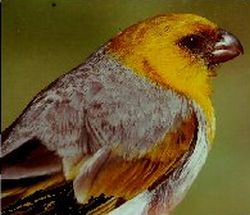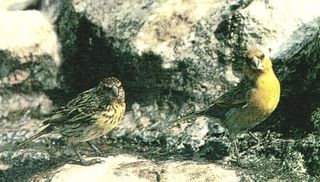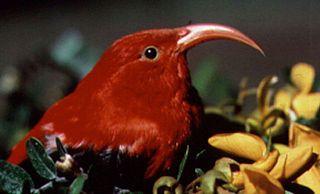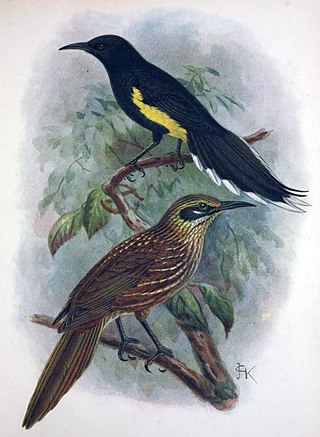
The true finches are small to medium-sized passerine birds in the family Fringillidae. Finches generally have stout conical bills adapted for eating seeds and nuts and often have colourful plumage. They occupy a great range of habitats where they are usually resident and do not migrate. They have a worldwide native distribution except for Australia and the polar regions. The family Fringillidae contains more than two hundred species divided into fifty genera. It includes the canaries, siskins, redpolls, serins, grosbeaks and euphonias, as well as the morphologically divergent Hawaiian honeycreepers.

Drepanis is a genus of Hawaiian honeycreeper in the subfamily Carduelinae of the family Fringillidae.

Loxioides is a genus of Hawaiian honeycreeper, in the subfamily Carduelinae.
Hawaiian honeycreepers (Fringillidae), of the subfamily Carduelinae, were once quite abundant in all forests throughout Hawai'i. This group of birds historically consisted of at least 51 species. Less than half of Hawaii's previously extant species of honeycreeper still exist. Threats to species include habitat loss, avian malaria, predation by non-native mammals, and competition from non-native birds.

The Oʻahu ʻakialoa is an extinct species of Hawaiian honeycreeper in the subfamily Carduelinae of the family Fringillidae. It was endemic to the island of Oʻahu in Hawaii.

The lesser ʻakialoa is an extinct species of Hawaiian honeycreeper in the subfamily Carduelinae of the family Fringillidae. It was endemic to the island of Hawaiʻi. It became extinct due to habitat loss and disappeared at around the same time as its Oʻahu relative.

Chloridops is an extinct genus of Hawaiian honeycreeper in the subfamily Carduelinae of the family Fringillidae.

The Lānaʻi hookbill is an extinct species of Hawaiian honeycreeper. It was endemic to the island of Lānaʻi in Hawaiʻi, and was last seen in the southwestern part of the island. George C. Munro collected the only known specimen of this species in 1913, which is housed in the Bernice P. Bishop Museum in Honolulu, and saw the species only twice more, once in 1916 and for a final time in 1918. No other sightings have been reported. They inhabited montane dry forests dominated by ʻakoko and ōpuhe. The Lānaʻi hookbill was monotypic within the genus Dysmorodrepanis and had no known subspecies. Its closest relative is believed to be the ʻōʻū, and some early authors suggested that the Lānaʻi hookbill was merely a deformed ʻōʻū. The Lānaʻi hookbill was a plump, medium-sized bird with greenish olive upperparts and pale whitish yellow underparts. It also had a yellow or white superciliary line and a white chin and throat. The wings also had a distinctive and conspicuous white wing patch. The hookbill's distinguishing characteristic was its heavy, parrotlike bill, which had the mandibles hooking sharply towards each other, leaving a gap between them when the beak was closed.

The Oʻahu ʻamakihi is a species of Hawaiian honeycreeper in the family Fringillidae. The male is rich yellow below, sharply contrasted with greenish upper parts. Females are duller and have two prominent wing-bars. It has a total length of approximately 4.5 inches (11 cm). It is endemic to the island of Oʻahu in Hawaiʻi, and is likely the only surviving honeycreeper endemic to the island.

Hemignathus is a genus of Hawaiian honeycreepers in the subfamily Carduelinae of the family Fringillidae. All species are endemic to Hawaii.

The Kauaʻi ʻamakihi is a species of Hawaiian honeycreepers endemic to Kauaʻi in the family Fringillidae. The species Hawaiian name is associated with is Kihikihi, or kihi, which stems from the word amakihi. Kihikihi, meaning curved, makes a reference to the bill of the Kauaʻi ʻamakihi. The Kauaʻi ʻamakihi has similar physical features to an extinct species, the Kauaʻi nukupuʻu. When flying or feeding, the Kaua’i ‘amakihi lets out a distinguishing tweet.

The greater ʻamakihi is an extinct species of Hawaiian honeycreeper in the subfamily Carduelinae of the family Fringillidae.

Himatione is a genus of Hawaiian honeycreepers in the subfamily Carduelinae of the family Fringillidae.

Paroreomyza is a genus of Hawaiian honeycreeper in the subfamily Carduelinae of the family Fringillidae. These birds are endemic to Hawaii.

Rhodacanthis, commonly known as the koa finches, is an extinct genus of Hawaiian honeycreeper in the subfamily Carduelinae of the family Fringillidae. All four species were endemic to Hawaii.

Telespiza is a genus of Hawaiian honeycreeper. All species in it are or were endemic to the Hawaiian Islands.
The hoopoe-billed ʻakialoa is an extinct species of Hawaiian honeycreeper in the subfamily Carduelinae of the family Fringillidae. It inhabited the islands of Kauaʻi and Oʻahu in Hawaii.

The Laysan honeycreeper, also known as the Laysan ʻapapane or Laysan honeyeater, is an extinct species of finch that was endemic to the island of Laysan in the Northwestern Hawaiian Islands. The bird was first recorded in 1828 and in 1892 received its scientific name from Walter Rothschild, who placed it in the genus Himatione along with the ʻapapane. The specific name, fraithii, refers to George D. Freeth, the self-appointed governor of Laysan, but was misspelled. Rothschild attempted to emend it to freethi in a later publication. This was accepted by most subsequent authors throughout the 20th century, and the bird was also considered a subspecies of the ʻapapane, as H. sanguinea freethii, for most of this time. By the 21st century, after further research, the original name was reinstated and it was considered a full species again. As a Hawaiian honeycreeper, a grouping within the finch subfamily Carduelinae, its ancestors are thought to have come from Asia.

Hawaiian honeycreepers are a group of small birds endemic to Hawaiʻi. They are members of the finch family Fringillidae, closely related to the rosefinches (Carpodacus), but many species have evolved features unlike those present in any other finch. Their great morphological diversity is the result of adaptive radiation in an insular environment. Many have been driven to extinction since the first humans arrived in Hawaii, with extinctions increasing over the last two centuries following European discovery of the islands, with habitat destruction and especially invasive species being the main causes.

Mohoidae, also known as the Hawaiian honeyeaters, was a family of Hawaiian species of now recently extinct, nectarivorous songbirds in the genera Moho (ʻōʻō) and Chaetoptila (kioea). These now extinct birds form their own family, representing the only complete extinction of an entire avian family in modern times, when the disputed family Turnagridae is regarded as invalid. The last surviving species in the family, the Kauai O'o, became extinct after 1987.





















